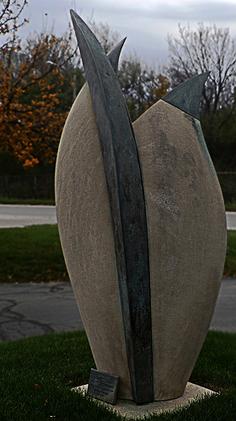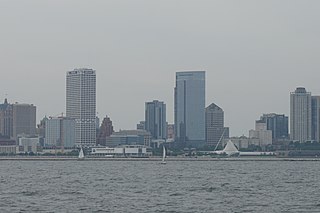
Milwaukee is the most populous city in the U.S. state of Wisconsin and the county seat of Milwaukee County. With a population of 577,222 at the 2020 census, Milwaukee is the 31st-most populous city in the United States, and the fifth-most populous city in the Midwest. It is the central city of the Milwaukee metropolitan area, the 40th-most populous metro area in the U.S. Milwaukee is categorized as a "Gamma minus" city by the Globalization and World Cities Research Network, with a regional GDP of over $102 billion in 2020.

The Milwaukee Riverwalk is a continuous pedestrian walkway along the Milwaukee River in downtown Milwaukee, Wisconsin.
RiverSculpture! are public art displays found along the Milwaukee Riverwalk in downtown Milwaukee, Wisconsin. Information kiosks stationed near each presentation offer self-guided walking tours of this annual outdoor exhibition.

The East Side is a district of Milwaukee, Wisconsin consisting of several neighborhoods encompassing an area just north of Downtown Milwaukee to the village of Shorewood, bordered by the Milwaukee River to the west and Lake Michigan to the east. The area encompasses residences, museums, bars, shops, theaters, live music clubs and the University of Wisconsin–Milwaukee campus.

The neighborhoods of Milwaukee include a number of areas in southeastern Wisconsin within the state's largest city at nearly 600,000 residents.

Nancy Metz White (1934–2018) was a Wisconsin artist with large-scale outdoor public sculptures installed in two parks in Milwaukee, Wisconsin. White welded and sometimes brightly painted steel and forge flashings reclaimed from Milwaukee heavy industry. She described herself as a practitioner of urban archeology.

Roy Frank Staab is an American artist.

The Calling is a public artwork by American artist Mark di Suvero located in O'Donnell Park, which is on the lakefront in Milwaukee, Wisconsin, United States. The artwork was made in 1981-82 from steel I-beams painted an orange-red color. It measures 40 feet in height, and it sits at the end of Wisconsin Avenue in front of the footbridge that leads to the Milwaukee Art Museum.

Wind Leaves is a public artwork by American artist Ned Kahn located on the downtown lakefront Pier Wisconsin in Milwaukee, Wisconsin, United States. It was created in 2006 and consists of a series of seven 30 ft (9 m) tall structures made from aluminum and stainless steel. The structures, which move with the wind, have leaf forms at the top covered by thousands of stainless steel disks.

Bay View Series is a public artwork by American artist Peter Flanary (artist) located on the Bay View Public Library grounds, which is on the south side of Milwaukee, Wisconsin, United States. Flanary's 1993 Bay View Series consists of three granite rocks and one chunk of taconite iron ore. All have text on them, and the iron ore piece has a hole in the middle. The largest piece measures approximately 68 x 77 x 28 in.

Float is a public artwork by American artist Peter Flanary located on the campus of the University of Wisconsin–Milwaukee in front of Sandburg Hall, which is in Milwaukee, Wisconsin, United States.

Chrysalis is a public artwork by American artist Beth Sahagian located at the entrance of the Marion Chester Read Center, which is near Wauwatosa, Wisconsin, United States. The sculpture is carved from 2,500 pounds of Indiana limestone and bronze. It consists of one solid form and measures about 75" x 36". Chrysalis was installed in the entrance of the Marion Chester Read Center in October 1990.
Truman Tennis Lowe (Ho-Chunk) was an American sculptor and installation artist. A professor of fine art at the University of Wisconsin, Lowe also served as a curator of contemporary art at the National Museum of the American Indian. He is known for large site-specific installation pieces using natural materials.
Sharing The Load is a public artwork by American artist Dan Leonhardt, located at Garden Park in the Riverwest neighborhood in Milwaukee, Wisconsin, United States. The sculpture is made of steel and stone and was installed by the artist in 1996.
Tip is a public art work by American artist David Middlebrook, located in the Riverwest neighborhood north of downtown Milwaukee, Wisconsin. The sculpture was created for Gordon Park as part of a revitalization initiative.

Connect is a public art work by artist Jeremy Wolf. It is installed in Riverside Park on the east side of Milwaukee, Wisconsin.
Fairies Candles is a public art work by artist Marina Lee. It was installed in Kilbourn-Kadish Park on a bluff overlooking the Milwaukee River near downtown Milwaukee, Wisconsin in 2005.
The Urban Ecology Center is a nonprofit organization in Milwaukee, Wisconsin. Their mission is to educate the Milwaukee community about the environment, conservation, sustainability, and other issues related to urban ecology, as well as to preserve and protect the natural areas in the city.

Downtown Milwaukee is the central business district of Milwaukee, Wisconsin. The economic and symbolic center of the city and the Milwaukee metropolitan area, it is Milwaukee's oldest district and home to many of region's cultural, financial educational and historical landmarks including Milwaukee City Hall, Fiserv Forum and the Milwaukee Art Museum. The city's modern history began in Downtown Milwaukee in 1795 when fur trader Jacques Vieau (1757–1852) built a post along a bluff on the east side, overlooking the Milwaukee and Menomonee rivers.













